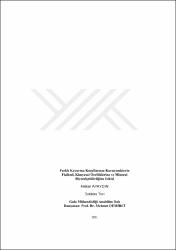| dc.description.abstract | Bu çalışmada farklı kavurma koşullarında üretilen badem, fındık, kaju ve leblebi örneklerinde oluşan fiziksel ve kimyasal değişimler incelenmiştir. Bu çalışmada kuruyemişlerde farklı kavurma koşullarında; % nem, su aktivitesi, renk (L*, a*, ve b*), tekstürel özellikleri (sertlik ve kırılganlık), akrilamid miktarı, aflatoksin miktarı, elementel içerik (Ag, Ca, Cd, Cu, Cr, Fe, K, Mg, Mn, Na, P, Pb, Se ve Zn) ve in-vitro sindirim sonucunda mineral biyoerişebilirliği (Ca, Fe, K, Mg, Mn, Zn, P ve Se) incelenmiştir. Çalışma sırasında çiğ bademde 140 – 180 °C'de 10 – 30 dk, çiğ fındıkda 140 – 180 °C'de 15 – 35 dk, çiğ kajuda 135 – 175 °C'de 8 – 40 dk, ön kavrulmuş leblebide son kavurma işlemi olarak 150 – 195 °C'de 10-40 dk kavurma işlemi uygulanmıştır. Çalışmanın ilk kısmında kuruyemişlerin her bir kavurma koşulundaki kalite kriterlerini oluşturan nem, renk ve testürel özellik değerleri analiz edilmiş ve en fazla tüketici beğenisini oluşturan değerler tespit edilmiştir. Buna göre duyusal olarak en yüksek değeri alanlar; bademde nem % 2,2±0,04, L* değeri 52,13±2,4, sertlik 987,5±95,16 g ve kırılganlık 0,44±0,07 mm fındıkta nem % 1,29±0,03, L* değeri 72,25±3,4, sertlik 241,98±8,18 g ve kırılganlık 0,34±0,04 mm olarak, kajuda nem % 1,99±0,099, L* değeri 61,01±2,32, sertlik 229,08±32 g ve kırılganlık 0,24±0,1 mm ve leblebide nem % 5,12±0,02, L* değeri 74,24±2,57, sertlik 218,02±18,27 g ve kırılganlık 0,46±0,09 mm olarak belirlenmiştir. Isıl işlem ile istenilen tad, renk ve tekstür özellikleri oluşsa da aynı zamanda Maillard reaksiyonuna bağlı olarak akrilamid de oluşmaktadır. Kavrulan kuruyemişlerde tespit edilen en yüksek akrilamid miktarları; bademde 120,25 ppb, fındıkta 67,33 ppb, kajuda 184,59 ppb ve leblebide 148,63 ppb olarak belirlenmiştir. Fındıkta diğer kuruyemişlere göre daha az akrilamid oluştuğu saptanmıştır. Çalışmanın ikinci kısmında ise kuruyemişlerin 14 farklı element için elementel içeriği ortaya konarak, kavurulan örneklerin in-vitro sindirim sonucunda mineral biyoerişebilirliğindeki değişim araştırılmıştır. Kuruyemişler arasında en yüksek Ca, P ve K miktarı bademde, en yüksek Ag, Mn ve Se miktarı fındıkta, en yüksek Cu, Fe, Mg ve Na miktarı kajuda ve en yüksek Zn miktarı leblebide belirlenmiştir. Mineral biyoerişebilirliğinin ısıl işlem ile azaldığı belirlenmiştir. Çiğ kuruyemiş örneklerinde mineral biyoerişebilirliği Ca için % 17,2 - % 38,8, Fe için % 11,9 - % 20,1, K için % 27,0 - % 39,5, Mg için % 29,6- % 46,8, Mn için % 13,4 - % 48,5, P için % 22,5- % 37,3, Se için % 10,6- % 41,8 ve Zn için % 12,9- % 38,2 aralığında tespit edilmiştir. Ca, Zn, P, Se ve K elementleri için in-vitro sindirim sonucunda en yüksek mineral biyoerişebilirlik değeri leblebide, Fe için bademde Mg için fındıkta ve Mn için kajuda tespit edilmiştir. Çalışma kapsamında aflatoksin bulaşışı da incelenmiş ve kuruyemiş örneklerinin hiçbirinde aflatoksin B1, B2, G1 ve G2 tespit edilememiştir. | en_US |
| dc.description.abstract | In this study, physical and chemical changes in almond, hazelnut, cashew and chickpea samples occured under different roasting conditions were investigated. In this study, dried nuts were roasted in different roasting conditions; % moisture, water activity, color (L *, a *, and b *), textural properties (hardness and fracturability), acrylamide content, aflatoxin content, elemental content (Ag, Ca, Cd, Cu, Cr, Fe, K, Mg, Mn, Na, P, Pb, Se and Zn) and mineral (Ca, Fe, K, Mg, Mn, Zn, P and Se) bioavailability after in-vitro digestion were investigated. Raw almond, raw hazelnut, raw cashew and pre-roasted chickpeas samples were roasted at 140 - 180 ° C for 10 - 30 min, at 140 - 180 ° C for 15 - 35 min, at 135 - 175 ° C for 8 - 40 min, at 150 - 195 ° C for 10-40 min, respectively. In the first part of the study, moisture, color and textural properties of nuts that constitute the quality criteria in each roasting condition were analyzed and the values that constitute the most consumer taste were determined. Accordingly, the highest sensory appreciation values; for almond; moisture 2.2 ± 0.04%, L* value 52.13 ± 2.4, hardness 987.5 ± 95.16 g and fracturability, 0.44 ± 0.07 mm for hazelnut; moisture 1.29 ± 0 %, 03, L* value as 72.25 ± 3.4, hardness 241.98 ± 8.18 g and fracturability as 0.34 ± 0.04 mm, for cashew; moisture 1.99 ± 0.099 %, L* value 61.01 ± 2.32, hardness 229.08 ± 32 g and fracturability 0.24 ± 0.1 mm and for roasted chickpea moisture 5.12 ± 0.02 %, L* value 74.24 ± 2.57, hardness 218.02 ± 18.27 g and the fracturability 0.46 ± 0.09 mm were determined. Although it creates the desired taste, color and texture properties with roasting, acrylamide is also formed due to the Maillard reaction during roasting. The highest amounts of acrylamide measured in roasted nuts; 120.25 ppb in almonds, 67.33ppb in hazelnuts, 184.59 ppb in cashews and 148.63 ppb in roasted chickpeas. Compared to other roasted nuts, the least acrylamide formation was determined in hazelnuts. In the second part of the study, the elemental content of the nuts for 14 different elements was determined. Also, the change in mineral bioavailability after in-vitro digestion was investigated. Among the nuts, the highest Ca, P and K amounts were found in almonds, the highest Ag, Mn and Se amounts were found in hazelnuts, the highest Cu, Fe, Mg and Na amounts were found in cashews and the highest Zn amounts were found in roasted chickpeas. It has been determined that mineral bioavailability decreases with heat treatment. Mineral bioavailability, in raw nuts, has been detected in the range 17.2% - 38.8% for Ca, 11.9% - 20.1% for Fe, 27.0% - 39.5% for K, 29.6% - 46% for Mg.8, 13.4% -48.5% for Mn, 22.5% -37.3% for P, 10.6% -41.8% for Se and 12.9% -38.2% for Zn. The highest mineral bioavailability ratio was determined for Ca, Zn, P, Se and K at roasted chickpea, for Fe at almonds, for Mg at hazelnut and for Mn for cashew after in-vitro digestion. flatoxin contamination was also examined in the study and aflatoxin B1, B2, G1 and G2 could not be detected in any of the nuts samples. | en_US |



















